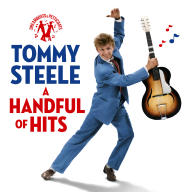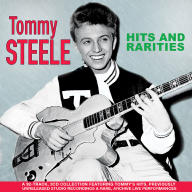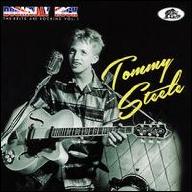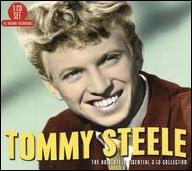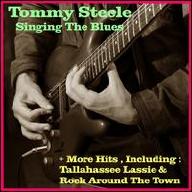During shore leave, he began appearing at American air force bases, among other venues, often with a country band called the Sons of the Saddle, led by a Canadian named Jack Fallon. Hicks made it a point, whenever he was ashore in the United States, to listen to as much music as he could find. In early 1956, he chanced to see Elvis Presley on the Dorsey Brothers' #Stage Show, and Milton Berle. During the spring of 1956, Hicks met Lionel Bart and Mike Pratt, two songwriters who were also working as performers and had an interest in this new brand of music that was coming over from America. At that time, Bill Haley's Rock Around the Clock had become a hit in England, but the new music wasn't yet sweeping the British charts the way it was in America -- Elvis' first single and album had received only limited release in the U.K., a result of the end, during early 1956, of EMI's longstanding licensing agreement with RCA-Victor. The particulars of rock & roll eluded many English listeners and even music professionals. The country had no blues tradition, and a contact with jazz that was restricted almost entirely to a very conservative, Dixieland-based style called "trad" (which, itself, wasn't welcomed in a lot of the best performing venues), which was starting to sell records. The blues and R&B elements of early rock & roll were imponderables to most teenage listeners and musicians, but the energy and the animated nature of the music were identifiable.
A breakthrough of sorts took place in 1955 when a guitarist/singer named Lonnie Donegan introduced a brand of music called skiffle, which mixed blues, folk, country, and jazz elements into a coherent whole that was lively and infectious to listen to, when it was done correctly. Donegan became skiffle's superstar and opened up major (although much shorter) careers for acts such as Wally Whyton and the Vipers Skiffle Group and American-born Johnny Duncan; more importantly, he inspired tens of thousands of British teenagers to buy acoustic guitars, to appropriate washboards, and to assemble washtub basses to play skiffle. It wasn't rock & roll, but it was closer to it than anything heard in England up to that point. Donegan, however, was born in 1931, and had already served in the British Army; he was not a teenager, and was more of a musician than a "star," although he did fill the latter role very well for years.
Tommy Hicks formed a band of his own, the Cavemen, with Bart and Pratt while he was on shore leave in London in the summer of 1956. In the summer of that year, Hicks and the Cavemen began playing in coffee bars in London's Soho, where young people were congregating in ever-larger numbers to hear the skiffle bands that were performing there. He was finding an audience, particularly at a coffee bar called the 2 I's, where Hicks the Cavemen were discovered by a public relations man named John Kennedy. Kennedy, in turn, convinced impresario Larry Parnes that there was something happening in Soho, and those teenage audiences and the musicians they were turning out to see, that could be turned into a viable national career for someone, and that Tommy Hicks the Cavemen had a good chance of doing just that. He was rechristened Tommy Steele, the first of a string of Parnes clients who took on names like Duffy Power and Billy Fury. Orchestrated by Parnes, Tommy Steele was given a big publicity buildup, booked into fashionable London clubs, and pushed as the new favorite of the upscale teenage female population. Parnes' campaign worked, and Steele was soon being scouted by numerous record labels. One of those executives who came down to the 2 I's was George Martin, the head of Parlophone Records, who passed on Steele. Instead, it was English Decca that signed Tommy Steele during the early fall of 1956. (Martin did end up signing the Vipers Skiffle Group.) For their recording debut, the trio cut an original song, Rock with the Caveman, with help from some British jazz notables (including saxman Ronnie Scott) who were billed as "the Steelmen." The new singing star made his television debut in October of 1956, and was immediately booked for a second appearance when thousands of letters arrived requesting to see him again. Rock with the Caveman made the British Top 20, a respectable start for a previously unknown artist working with one of his own songs.
Listening to it today, it seems a curiously bland, formulaic effort at rock & roll, its use of the word "rock" in the lyrics more than its style identifying it, though he and the band do play hard. In order to appreciate it, however, one must recognized what the state of English popular culture was during the second half of 1956. At that time, a few British jazz bands were beginning to add rock & roll to their repertoires or, in some cases, retooling themselves entirely. Tony Crombie His Rockets, in particular, were starting to make a lot of noise and names for themselves at dances. Their model was Bill Haley's Comets; this band and others like it were sax-driven, with lots of rhythm guitar (good lead guitarists being almost impossible to find), their songs relying on rousing repetitive choruses and a heavy beat, rather than any particular cleverness or flair in their lyrics -- forget Chuck Berry, the Brits didn't even have anyone with Bill Haley's nonexistent songwriting ability in their midst. And, as was the case with Haley, none of them was especially youthful or particularly charismatic, and English teenagers found little of it compelling. Then along came Tommy Steele, who was all of 19 years old and sang and played a guitar. He had a toothy smile, wore his hair in what was considered an unkempt manner (compared with the proper way most English performers groomed themselves), and seemed possessed of boundless energy and humor. He was no blues singer or stylist like Elvis Presley, his voice more pleasant than powerful, his demeanor more genial than threatening, but the latter was actually a point in Steele's favor in becoming a star in England -- Elvis' overtly sexual presence gave Americans pause, and would have been impossible to emulate in England. His songs, especially the early ones, were uniquely English variants on a rock & roll sound, honking saxes in front of a basic rhythm guitar and piano backing, with maybe a little moderately amplified jazz-type lead guitar (Doomsday Rock) and lyrics that included lines like "The British Museum's got my head" (on Rock with the Caveman). They did the job, as did covers of American hits like Melvin Endsley's Singing the Blues and the Charlie Gracie hit Butterfly.
Only a month after Rock with the Caveman made the British Top 20, Steele was voted one of the Top Ten male British singers in a New Musical Express poll, and on his first major tour, found himself greeted by hoards of screaming fans. His second single, Doomsday Rock, failed to chart, but his third, Singing the Blues, bumped Guy Mitchell's version from the number one spot on the British charts. By early 1957, Steele had made his first screen appearance, in a small role as a singer in the thriller #Kill Me Tomorrow, directed by Hammer Films alumnus Terence Fisher. By February of that year, the production of the movie #The Tommy Steele Story had begun. Shot in less than three weeks, it was in theaters in May of 1957, just in time to herald his second major British tour, on which he was billed with the American rock & roll band Freddie Bell the Bellboys. There were also the Decca albums, The Tommy Steele Stage Show, and other early 10" LPs, which had a decent quota of well-played songs. Two songs from #The Tommy Steele Story, Handful of Songs and Water, Water, later charted in the British Top Five. Steele displayed more versatility with the calypso-flavored Water, Water, the orchestrated pop song Butterfingers, and also the folkish number Shiralee, which was recorded for the movie of the same name. The latter was a most impressive performance, showing a depth and maturity that had previously eluded him.
Everything associated with Steele seemed poised for success. Among his two Cavemen associates, Lionel Bart later went on to compose the musical Oliver!, which became one of the most massively popular British musicals in history, and which yielded a hit blockbuster film (one of the last old-style musicals of the '60s to turn a significant profit for its makers) from Columbia Pictures in 1968. Mike Pratt, for his part, became a television star in England. Steele's second movie, #The Duke Wore Jeans, was in production in September of 1957, and the following month English audiences voted him the number two World Music Personality, outpolled only by Elvis Presley. That same month, he was the star of his own television special, and appeared in #The Royal Variety Show before an audience that included members of the Royal Family. The following year, Steele made his first international tour, of Europe and South Africa, which was followed by a British tour on which, at Dundee, he was mobbed by fans and injured so seriously that he was forced to take two months off from performing. During the summer of 1958, Steele appeared in the premiere episode of #Oh Boy!, a new televised musical showcase whose lineup also included a newcomer to professional music named Cliff Richard. It was a harbinger of things to come. Steele continued to record some rock & roll, including a version of Ritchie Valens' Come on, Let's Go (which was produced by Joe Meek), but increasingly, his output consisted of pop-style numbers, including show tunes. Give! Give! Give! b/w Tallahassee Lassie were his last rock & roll sides, in 1959. Steele's version of the Freddy Cannon hit is perfectly credible rock & roll. By that time, Cliff Richard and his backing band, the Shadows, had ushered in a new wave of British rock & roll with Move It -- an original song that felt and sounded American -- and its immediate follow-up records. It was Richard, not Steele, who starred in #Expresso Bongo (1959), a film based on a satirical play that had been inspired by Steele's rise to fame.
From the beginning, Steele had aimed at having a career as a more diversified entertainer, in part out of personal preference -- he liked American rock & roll, but he also appreciated other kinds of music -- and some biographers believe that the 1958 incident in which he was injured pushed him into the decision to move out of rock & roll once and for all. Additionally, the direction of Steele's career out of rock & roll proved to be a typical career course for Parnes' clients, and most British rock & roll stars (and, for that matter, many of the biggest white American stars, most obviously Elvis). Some of it was a result of expediency -- nobody knew how long the teenage fixation on rock & roll would last, and managers and the artists themselves wanted to maintain their careers and build on it, not become trapped in a musical genre that, it was presumed, could go stale for the public at any time. Steele remained popular with younger listeners, and was voted among the Top Five British male singers of 1959. He did two more movies that year, #Tommy the Toreador and #Light Up the Sky, the latter a World War II comedy that also featured comedian Benny Hill. His single You Were Mine (a cover of the Fireflies hit) failed to chart, but in 1960 he scored another Top Ten single with Little White Bull, a soft children's song (Steele contributed all of the royalties to the Children's Cancer Research fund) from #Tommy the Toreador. An Australian tour followed, which reunited him with the Steelmen and also featured a 15-piece backing band led by Harry Robinson aka Lord Rockingham. Steele got married that June to Ann Donoghue, but apart from a week's honeymoon, barely slowed his career. He spent that summer appearing at the Blackpool Opera House in a record-breaking season with veteran entertainer Alma Cogan.
Most British teenagers thought of Steele as passe by 1960, however. It was four years since he'd broken into the charts, and a whole new wave of children had reached their teen years, listening to Elvis (whose records, a little later than they did in America, did top the charts in England), Gene Vincent, Buddy Holly, Cliff Richard, Billy Fury, and other much harder sounds than Tommy Steele. In a sense, however, Steele was more successful than any of them in advancing out of rock & roll, which was what he wanted to do. By 1963, he was a new sensation on the London stage in the musical Half a Sixpence (based on the H.G. Wells novel -Kipps), and he followed this with a hit run on Broadway in the same play two years later. Steele had successfully reinvented himself. Two years after the opening of the show's Broadway run, he did a Hollywood hat trick that he could scarcely have dreamt of when he formed the Cavemen 11 years earlier, by starring in three big-budget studio films in a single year -- the film version of #Half a Sixpence, the Disney film #The Happiest Millionaire, and #Finian's Rainbow. In contrast to his low-budget rock & roll movies, none of which took more than three weeks to film and most of which were dumped on the American market, these were color, widescreen movies shot over a period of months and given a wide release all over the world. #Finian's Rainbow, in particular, was something of a pinnacle in Steele's feature film career, teaming him up with Fred Astaire and Petula Clark, both of whom were already established screen stars (in Astaire's case, a legend) when he was still working for Cunard -- not bad for a working-class boy who had to go to sea when he was 15. Steele's rock & roll era was well behind him by the time the smoke cleared from this series of big films. From that day forward, when he did perform, it was far more likely to be songs like Half a Sixpence than Rock with the Caveman, or even Singing the Blues. He has played more legitimate theater and big-budget musicals than rock & roll for more than 35 years and, as a more personal creative endeavor, has also cultivated a flair for art and graphic design.
Tommy Steele's reputation as a rock & roller over the years has risen and fallen, depending upon the which side of his music output was available and who was doing the writing. A lot of Britons who were simply kids listening to records back when he started making them still love his work to this day (Decca was reissuing his original LPs as 10" discs in the early '80s), and few Englishmen over the age of 25 have harsh words to say about him. Some scholars and historians feel differently, deriding Steele as a manufactured pretender rather than a real rock & roller. Other call him "the most innovative and influential act of the 1950s" in England, although that's a bit extreme -- Lonnie Donegan and Cliff Richard are certainly in the running for that designation. Steele's success as a rock & roller was important, vitally so, in several respects. His music proved that English musicians could, after a fashion, write and play something roughly akin to American-style rock & roll without being too loud or crude (two impediments to rock & roll's acceptance, or at least being tolerated, in England); additionally, his success drew a major British record company into rock & roll, which was doubly important considering that Decca had passed on signing Lonnie Donegan a year earlier because they doubted that the skiffle boom would last. Additionally, his music and its success were also a vital link in the chain of evolution from Lonnie Donegan to Cliff Richard, which helped pave the way, indirectly, for the Beatles and all that followed. Most important at the time, he was the first English teenager to elicit excitement with his music from the mass public and, incidental to his popularity, he wrote or co-wrote many of his own songs in the beginning (which was understandable, in part, because few professional songwriters in England at that time could compose rock & roll). Performers such as Cliff Richard, the Beatles, and the Rolling Stones (who provoked a legendary riot at Royal Albert Hall in October 1966, just by taking the stage) would elicit stronger reactions, but Steele was the English teenager who let the genie out of the bottle, even if he wasn't the genie. ~ Bruce Eder, Rovi


